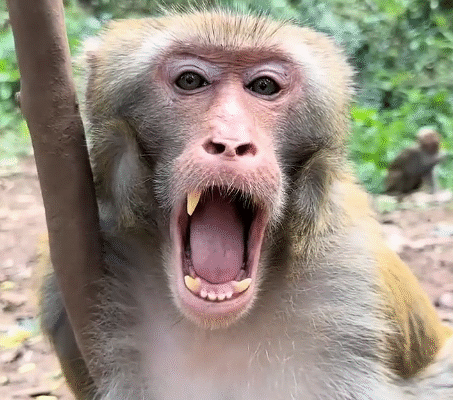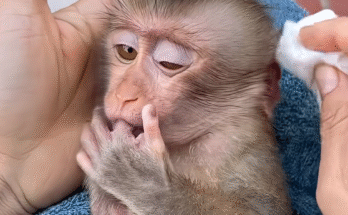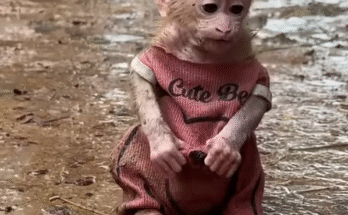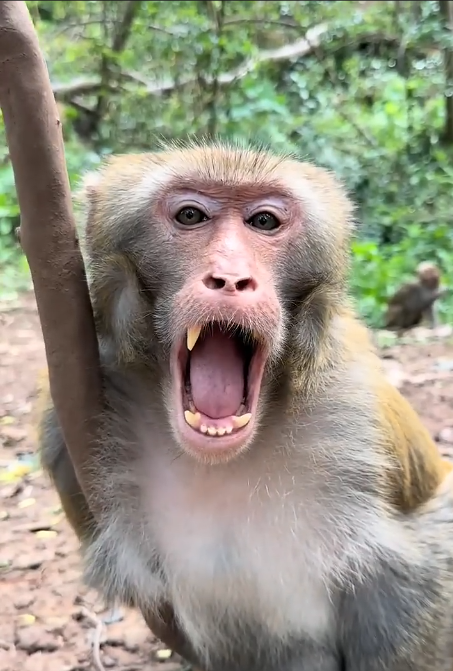
In the quiet outskirts of a bustling village, where children’s laughter often mixed with the honking of motorbikes and the distant calls of street vendors, there lived a monkey who became quite famous for one unusual talent — his ability to act. Unlike most monkeys who were content with swinging from trees, chasing bananas, or stealing fruit from unsuspecting passersby, this particular monkey had a natural gift for performance. The villagers called him Bonto, but he was more popularly known as the Good Acting Monkey.
A Curious Beginning
Bonto’s story didn’t begin in fame. He was just an ordinary little macaque, playful and mischievous like the rest of his troop. He often followed his mother through the forest canopy, tumbling from branch to branch, always eager to see what the humans in the village were up to. What set him apart, however, was his sharp observation skills.
While other monkeys simply snatched food and ran, Bonto lingered. He watched the children play pretend, imitating heroes from television shows. He studied the way the villagers laughed when someone made a funny gesture, or how they gasped when someone pretended to be sad. Slowly, Bonto began to copy these actions when he was alone — pretending to cry, acting scared, or mimicking the way people bowed their heads dramatically when telling stories.
The first time his talent was noticed was by a group of children. One hot afternoon, they spotted Bonto near the well, sitting on the edge with a droopy face, covering his eyes with his tiny hands as if he was heartbroken. Curious, the children gathered around. Then, suddenly, Bonto peeked out, flashed a mischievous grin, and dramatically pretended to faint. The children burst out laughing.
From that day forward, Bonto’s reputation grew.
The Monkey Actor
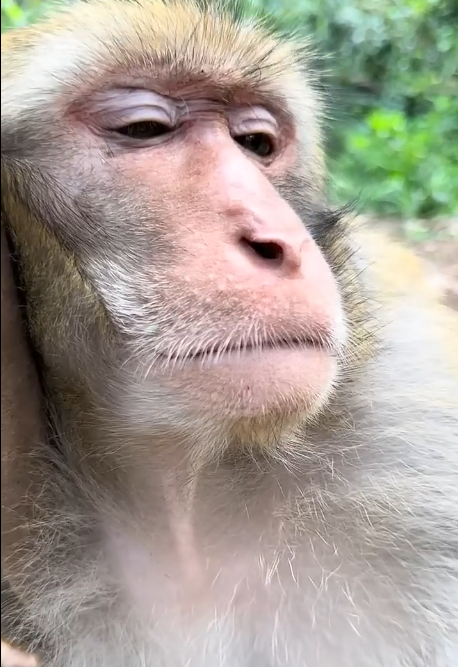
The villagers discovered that Bonto wasn’t just playing — he could perform. If someone clapped and asked him to “act sad,” he would instantly cover his face, slump his shoulders, and let out a soft whining sound. If they told him to “be angry,” he would stomp his feet, shake his arms, and glare fiercely. His comedic timing was impeccable. When the crowd expected him to stop, he would exaggerate his act, sending people into hysterics.
A street performer named Ramesh, who often juggled and told stories in the market, saw Bonto one day and realized that this monkey had the potential to be a star attraction. With patience and gentle training, he began working with Bonto, not to force tricks, but to encourage his natural acting skills. Unlike many performing animals that were mistreated, Bonto thrived under Ramesh’s care. He was treated like a partner, given plenty of food, rest, and affection.
Soon, Ramesh and the Good Acting Monkey became inseparable. They would set up in the village square, and a crowd would gather. Ramesh would narrate short skits, and Bonto would act them out.
“Once upon a time,” Ramesh would say, “there was a brave soldier who fought a dragon!”
At this cue, Bonto would puff out his chest, march proudly like a soldier, then suddenly shrink back, wide-eyed, pretending to tremble at the sight of an invisible dragon. He’d raise his stick like a sword, charge forward, then dramatically fall to the ground, playing dead until the children shouted, “Get up, hero!” With a sudden leap, Bonto would spring up, strike a triumphant pose, and bask in the audience’s applause.
Fame and Love
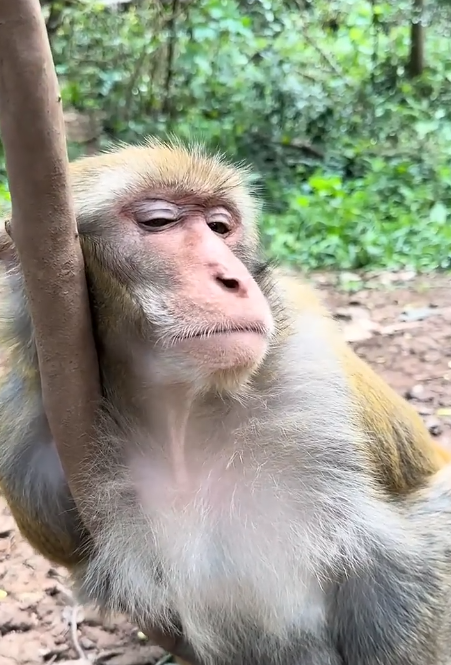
News of the Good Acting Monkey spread beyond the village. People from nearby towns began to visit just to watch him. Some even filmed his performances on their phones, sharing them widely. Soon, Bonto became a small local celebrity.
But what truly made him beloved was not just his ability to act — it was the emotion behind his performances. When he acted sad, he would sit quietly, gazing downward, and even the toughest men felt a tug at their hearts. When he pretended to cry, children would rush forward to hug him, laughing as he suddenly switched to a cheeky grin. His gift was more than mimicry; it was connection.
Ramesh noticed this and always made sure to keep Bonto’s shows lighthearted and positive. “He’s not just a monkey,” Ramesh would say proudly, “he’s a storyteller in his own way.”
The Festival Performance
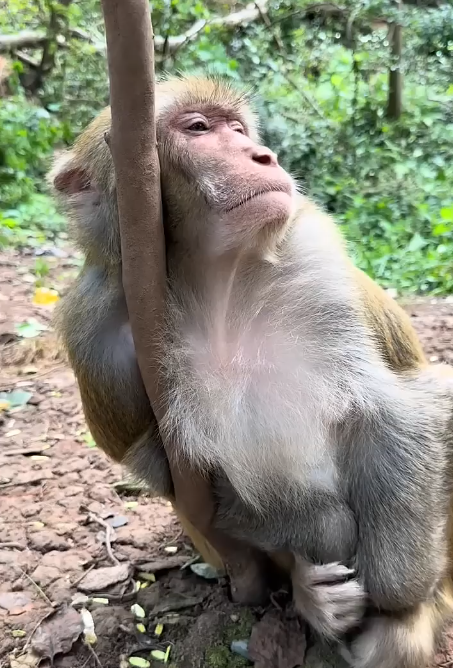
One year, the village announced a cultural festival, inviting performers from across the region. Singers, dancers, and musicians prepared for weeks. Ramesh decided to enter Bonto into the festival, though some villagers laughed at the idea.
“A monkey? Competing with trained dancers? Impossible!” they scoffed.
But Ramesh believed in Bonto. He prepared a special act where Bonto would play three roles — a poor farmer, a greedy landlord, and finally a wise teacher who taught kindness. It was ambitious, but Ramesh knew Bonto could do it.
On the day of the festival, the stage was crowded with colorful performers. When Bonto’s turn came, the audience was curious but skeptical. Then the act began.
First, Bonto appeared as the poor farmer, pretending to plow the land, wiping imaginary sweat from his brow, and begging for food. His sad face was so convincing that the audience grew silent. Then, in a flash, he transformed into the greedy landlord, strutting arrogantly, clutching imaginary coins to his chest, and shooing the farmer away. The crowd booed at the landlord’s cruelty.
Finally, Bonto switched to the teacher role. He sat cross-legged, rubbed his chin like a wise old man, then gently beckoned the landlord and farmer together, joining their hands as if teaching them compassion. The ending was simple but powerful.
The audience erupted in applause. Some even had tears in their eyes, amazed that a monkey could deliver a performance with such emotion. That night, Bonto and Ramesh received the festival’s special award for “Creativity and Inspiration.” From then on, no one doubted the Good Acting Monkey.
A Symbol of Joy
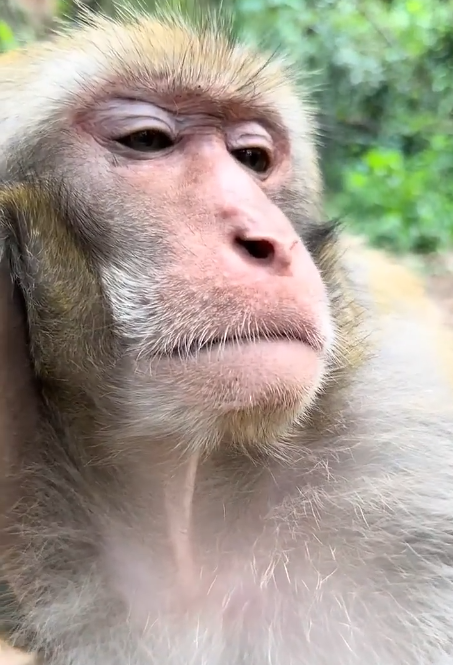
Bonto’s fame grew, but he never lost his playful spirit. When not performing, he loved climbing trees, playing with children, and snatching bananas from unsuspecting vendors — always flashing that cheeky grin afterward. He became a symbol of joy and unity for the village. Strangers who came to watch him often left with smiles and lighter hearts.
His story also carried a quiet lesson. Many villagers realized that talent and beauty can come from the most unexpected places. A monkey, often seen as a mischievous nuisance, had brought laughter, wisdom, and pride to their community.
Conclusion
The Good Acting Monkey was more than an entertainer. He was a bridge between humans and animals, a reminder that emotions are universal and that joy can be found in the simplest of expressions. Bonto’s story was told again and again, not only as a tale of an extraordinary monkey but also as an inspiration to nurture and appreciate the gifts that life presents — no matter how unlikely they seem.
Even as years passed and new performers came to the village, people never forgot Bonto. His legacy lived on in every laugh he created, every heart he touched, and every child who believed, if only for a moment, that even a monkey could be the best actor in the world.
